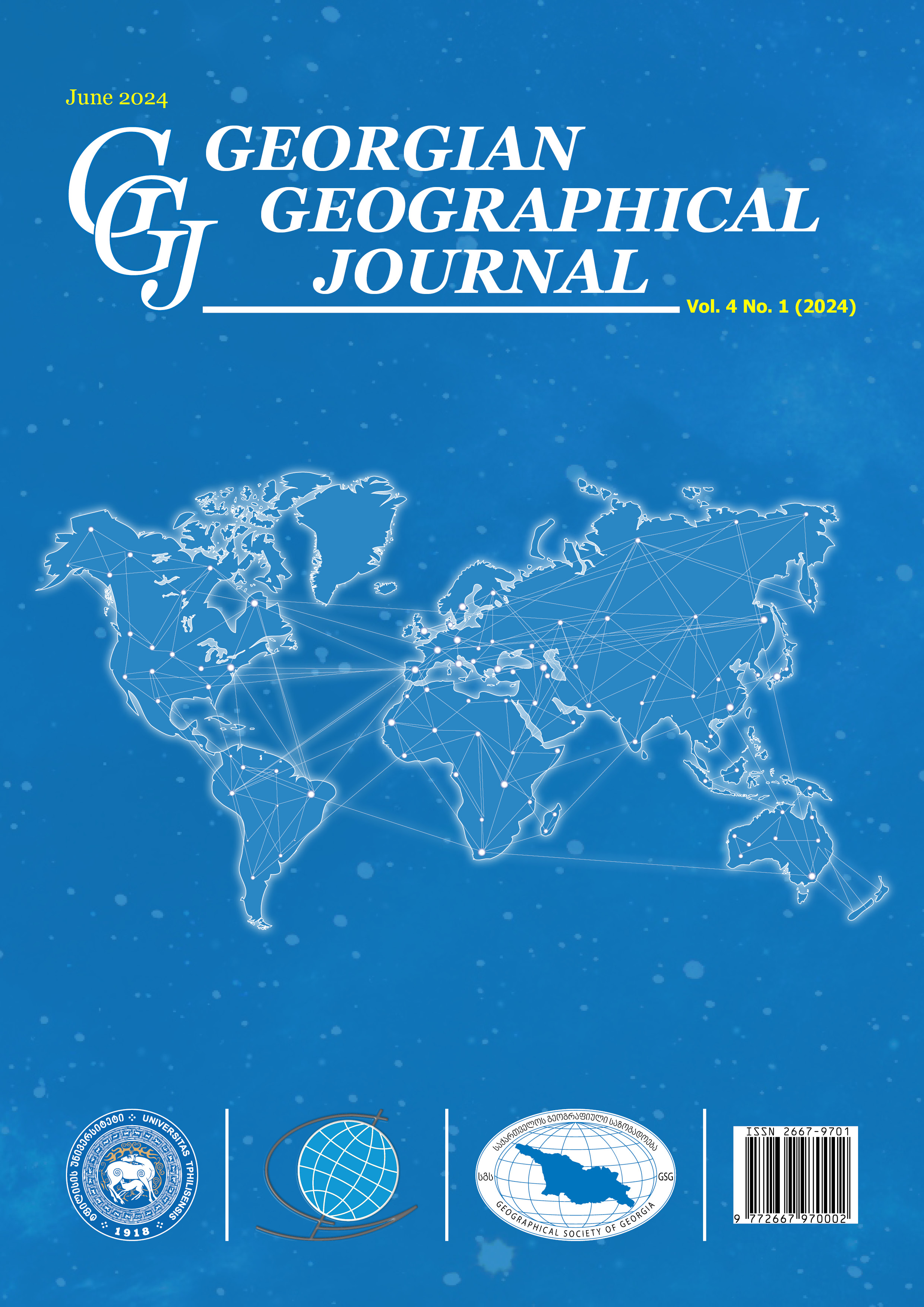Analysis of Spontaneous Exodynamic Processes in the Dghviora River Basin Taking into Consideration the Perspectives of the Shovi-Glola (Georgia) Tourist Agglomeration
DOI:
https://doi.org/10.52340/ggj.2024.04.01.04Keywords:
Exodynamic processes, rockslides, mudflows, threats to tourismAbstract
River Dghviora originates from the much-modified cirque of the vanished glacier on the northern slope of the Shoda-Kedela mountain range, parallel to the Central Caucasus. The glacial and erosive-glacial relief of the nival zone is developed here, with clearly defined troughs, moraines, individual erratic boulders. At relatively low hypsometric levels, alpine and subalpine landscapes are represented. The building rocks of the valley, along with the slope of its bed and climatic conditions, are the main factors of the formation and development of exodynamic processes. The material coming from Dghviora river, and its parallel valleys flows into the Chanchakhi valley and forms a large withdrawal cone at the confluence, on which the village of Glola is built. From here, destructive mudflows arise during heavy rains, because of which this and other settlements are damaged. In July 2020, because of heavy rains, due to the overflow of Rioni, Chanchakhi, its abovementioned and other tributaries, destructive mudflows were formed, which destroyed the infrastructure, highways and bridges of the villages of region Zemo Racha. The purpose of the article is to analyse the mechanism of occurrence of natural processes and to assess their impact on the tourist agglomeration of Shovi-Glola, as well as to predict the further development of these processes as much as possible and to present preventive measures.
Downloads
References
Abutidze O., Gvadzabia V., Gaprindashvili M. (2010). Report of the Geological Department of the National Environment Agency. [In Georgian].
Adamia Sh., Gujabidze G. (2004). Geological Map of Georgia. Scale: 1:500,000, Georgian Department of Geology (ISTC Project).
Arefiev, S. S., Rogozhin, E. A., Bykova, V. V., & Dorbath, C. (2006). Deep structure of the Racha earthquake source zone from seismic tomography data. Izvestiya. Physics of the Solid Earth/Izvestiya, Russian Academy of Sciences. Physics of the Solid Earth, 42(1), 27–40. https://doi.org/10.1134/s1069351306010034
Chernomorets S. (2006). Selevie issledovania v Rossii I ctranax bivshego Sovetskogo Soiuza. In: Izmenenia prirodnoi sredy na rubeje tisiachiletii. Tbilisi-Moskow. PH Poligraf pp. 67-75. (in Russian).
Cánoves, G., Villarino, M., Priestley, G. K., & Blanco, A. (2004). Rural tourism in Spain: an analysis of recent evolution. Geoforum, 35(6), 755–769. https://doi.org/10.1016/j.geoforum.2004.03.005
Dokukin M. D., Savernyuk E., Chernomorets S., (2015). Obval’nie processi v visokogornoi zone Kavkaza v XXI veke, Journal Priroda, №7, pp. 52. (in Russian)
Gavasheli A. (1978). Upper Racha and its Natural Resources. Tbilisi, p. 54. (In Georgian).
Map of mudflow hazards in Transcaucasu and Dagestan/Karta selevoi opasnosti Zakavkazia I Dagestana (1989). Scale: 1:1,000,000. Ed. G. I. Kherkheulidze. M., GUGK SSSR. (in Russian).
Ovsyuchenko, A.N., Marakhanov, A.V., Novikov, S.S., and Lar’kov, A.S., (2011). Peculiarities of Seismotectonics and the Ancient Earthquakes of South Ossetia, Part 2, Vestn. Vladikavkaz. Nauchn. Tsentra (Bulletin of the Vladikavkaz Scientific Center), vol. 2, no. 4.
Salukvadze, E. (2022). Environmental and anthropogenic factors in the development of geodynamical processes in Racha. Georgian Geographical Journal. https://doi.org/10.52340/ggj.2022.753
Sharashenidze, Sh. (1940). Shovi Mineral Springs Resort (Upper Racha). Anniversary collection of Tbilisi State University. Tbilisi, p. 16-17. (In Georgian).
Tsereteli, E. (1965). The nature of modern glaciation in riv. Chanchakhi basin (Upper Racha, Georgia). Proceedings of the Geographical Society of Georgia. Vol. 8, p. 71-76. (In Georgian).
Tsereteli, E. et al (1985) Injerno-geologicheskoe raionirovanie Gruzii po stepeni razvitia opasnix geologicheskix processov. Scale: 1:200,000. (in Russian). Jaoshvili V. (1996) Population of Georgia, "Metsniereba", Tbilisi, p. 364. (In Georgian).
Tsereteli, E., Gaprindashvili, G., Gaprindashvili, M., Bolashvili, N., & Gongadze, M. (2018). Hazard risk of Debris/Mud flow events in Georgia and methodological Approaches for management. In Springer eBooks (pp. 153–160). https://doi.org/10.1007/978-3-319-93136-4_19
Vakhushti Batonishvili (1973). Description of the Kingdom of Georgia. In: Kartlis Tskhovreba (Life of Georgia). Volume IV. "Sabchota Saqartvelo", Tbilisi., p. 768. (In Georgian).
Downloads
Published
How to Cite
Issue
Section
License
Copyright (c) 2024 Georgian Geographical Journal

This work is licensed under a Creative Commons Attribution 4.0 International License.
This work is licensed under a CC BY Attribution




